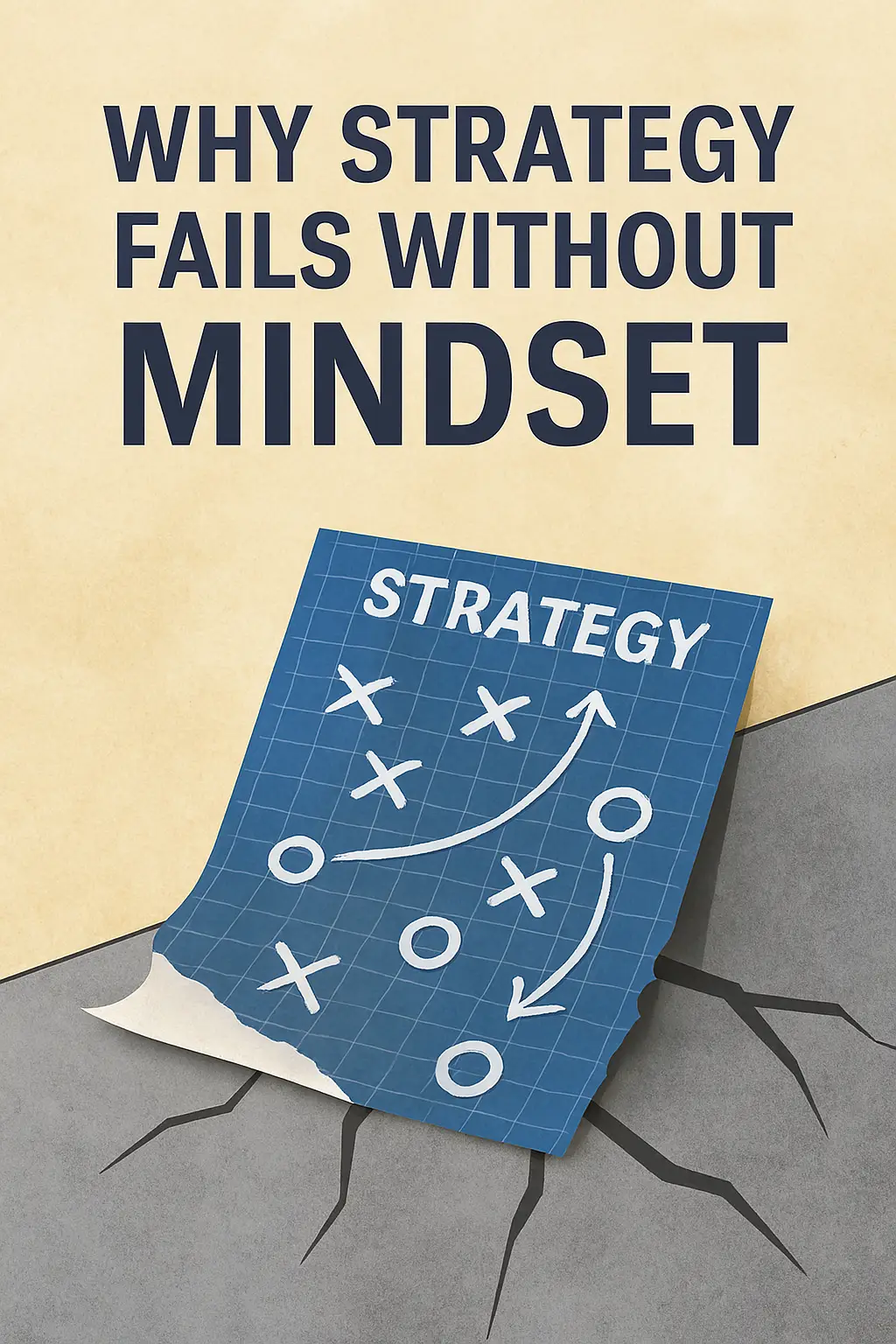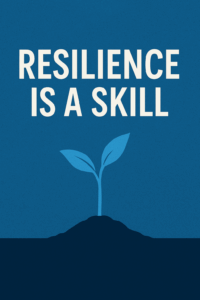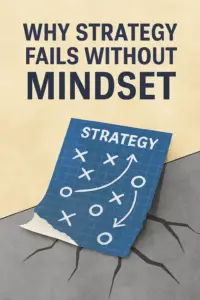The Illusion of the Perfect Plan
Business schools and boardrooms love strategy. We map markets, analyze competitors, and design elegant plans. Yet time and again, even the most sophisticated strategies collapse. This is why strategy fails without mindset: even the best plan will collapse without the right foundation.
Mindset is the operating system that determines whether strategy lives or dies. Without the right mindset, even the best plan will fail in execution.
The Hidden Gap Between Strategy and Execution
Leaders often assume that once a strategy is clear, execution will follow. But research shows that up to 70% of strategies fail in implementation (Harvard Business Review). The missing link is not intelligence or resources. It is mindset.
Short‑Term vs. Long‑Term Mindset
As Bruce Lee put it, “Long‑term consistency trumps short‑term intensity.” (Elevate Society). A short‑term mindset chases bursts of effort and quick wins, often burning out. A long‑term mindset values steady, sustainable progress. In business, that means investing in systems, people, and culture that compound over time rather than chasing quarterly spikes.
Fixed vs. Growth Mindset
Psychologist Carol Dweck illustrates this in Mindset: The New Psychology of Success. A student with a fixed mindset who struggles on a math problem might think, “I’m just not good at math,” and give up. A student with a growth mindset reframes it as, “I haven’t figured this out yet,” and keeps working until they improve (summary here). That small shift in belief changes effort, resilience, and ultimately results.
Scarcity vs. Abundance Mindset
Napoleon Hill, in Think and Grow Rich, wrote: “Remember, no more effort is required to aim high in life, to demand abundance and prosperity, than is required to accept misery and poverty.” (Think and Grow Rich Tips). A scarcity mindset accepts limits and settles for less. An abundance mindset channels the same energy into growth and opportunity. Leaders who operate from abundance see possibilities where others see constraints.
Why Mindset Shapes Strategy
Culture Transmission
Mindset is contagious. A leader’s mindset sets the tone for the entire organization.
Perception Filters
Mindset determines what leaders notice. A scarcity mindset sees threats. An abundance mindset sees opportunities.
Decision‑Making
Mindset shapes whether leaders double down on failing strategies or pivot toward new possibilities.
From Old Mindset to New Mindset
Shifting strategy requires shifting the lens you see it through. Here are some of the most common mindset traps, and the new perspectives that unlock execution:
From Old Mindset to New Mindset
- Old: Strategy is fixed; once the plan is written, stick to it.
New: Strategy is adaptive; the plan is a living document that evolves with reality. - Old: Failure is final; if the plan does not work, it proves the idea was wrong.
New: Failure is feedback; setbacks are signals to refine and improve. - Old: Leaders must have all the answers.
New: Leaders model learning, ask questions, and adapt openly. - Old: Short‑term wins prove success.
New: Long‑term resilience sustains success. Quick wins matter, but culture and adaptability matter more. - Old: Mindset is personal.
New: Mindset is cultural. The leader’s mindset sets the tone for the whole team.
Why Strategy Fails Without Mindset in Practice
Case Example 1: The Startup That Could Not Pivot
I once worked with a startup that had a brilliant product but a rigid mindset. Their strategy was airtight on paper, but when the market shifted, they refused to adapt. They saw change as a threat rather than an opportunity. Within a year, competitors overtook them. Their failure was not strategic. It was mental.
What kept me pushing them was my belief that they could adapt if they trusted the process. That expectation often unlocked more than the plan itself.
Case Example 2: The Classroom Pivot
In teaching, I saw the same principle. A lesson plan is a strategy. But when students disengaged, the plan failed unless I shifted my mindset. Sometimes that meant changing the lesson on the spot, putting it aside for another day, and moving to a different area.
If students were deeply engaged, I let the lesson run longer than planned. If they were restless or checked out, it was time to shift to another subject or activity. Situational awareness and social awareness, using empathy skills to read the room, made all the difference.
At times, the pivot was not about the lesson at all. Sometimes the tension in the room needed to be addressed directly. Maybe something had happened at recess, or a conflict between students was simmering under the surface. In those moments, the most effective strategy was to stop everything and deal with what was really going on.
My belief in their ability to rise to the moment, paired with the expectation that they could, often turned the class around more than the lesson plan itself.
Case Example 3: Fitness and Plateau Busting
In fitness, plateaus are inevitable. The body adapts, and progress stalls. The real breakthrough comes not from changing the program on paper, but from shifting the mindset in the moment.
One client I trained used to throw up after every workout and thought that was normal. When I asked what he ate or drank beforehand, he admitted to drinking orange juice. I explained that the acid in orange juice, combined with the lactic acid produced during exertion, was causing the problem. Once he cut it out, he could train harder and recover better. The barrier was not his body, it was his approach.
With other clients, I never set a fixed number of reps. Instead, I would keep saying “one more rep” until they truly could not lift another. That simple shift broke through self‑imposed limits and shattered plateaus. The strategy was not about the numbers on the page. It was about cultivating the mindset to push past what they believed was possible.
What made the difference was not just the program but my belief in their strength and the expectation that they could go further than they thought possible.
The Three Mindsets Every Strategy Needs
- Growth Mindset — See setbacks as feedback and opportunities to learn.
- Adaptive Mindset — Stay flexible and pivot when conditions change.
- Purpose‑Driven Mindset — Anchor strategy to meaning so people stay committed when challenges arise.
How to Align Strategy and Mindset
- Start With Mindset Training
Before rolling out a new strategy, invest in mindset workshops, coaching, or reflective practices. - Embed Mindset in Culture
Celebrate learning, not just outcomes. Reward adaptability. Normalize experimentation. - Link Strategy to Purpose
Show how the plan connects to a larger mission. Purpose fuels resilience. - Model the Mindset
Leaders must embody the mindset they want to see. Strategy is caught more than it is taught.
Bringing It Together
Strategy without mindset is fragile. It looks good on paper but collapses in practice. When leaders cultivate growth, adaptability, and purpose, strategy becomes more than a plan. It becomes a living system that evolves with reality.
Explore more in the Insights section, where resilience and neuroplasticity connect with strategy to fuel sustainable growth.



